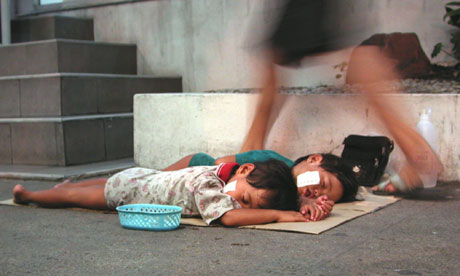 Posted by Andrew Chambers 19 January 2011: guardian.co.uk
Posted by Andrew Chambers 19 January 2011: guardian.co.uk Where does the poverty line truly lie? Defining deprivation isn't a mere academic exercise – it informs and creates policy. Middle-income countries such as Thailand illustrate the dangers of a simplistic approach
 Photograph: Barbara Walton/EPA: Thailand has achieved many of its millennium development goal targets, but pockets of poverty still exist.
Photograph: Barbara Walton/EPA: Thailand has achieved many of its millennium development goal targets, but pockets of poverty still exist. Thailand is a development success story. The country is on target to meet or exceed all its millennium development goals (MDGs), and absolute poverty ($1 a day) is now less than 2%.
However, do these statistics accurately measure what poverty is, and what is the next step in poverty reduction for middle-income countries like Thailand?
How to define and measure poverty, therefore, is not just a dry academic debate, as these decisions greatly affect what policies are pursued.
Only a few minutes from the five-star hotels of downtown Pattaya, Soon Ton lives in a small urban slum built on dusty wasteland. She is one of the increasing numbers of Thais who have left their rural villages to seek work in the cities. Her house, which she shares with her elderly mother, is a ramshackle mix of scavenged corrugated iron and plywood. There's no running water and she only recently got electricity in her home. However, by sifting through rubbish bins she is able to collect enough recyclable material to make more than 200 baht (£4) a day. This puts her well above the MDG and national poverty lines. So, in terms of absolute measures of poverty, Soon Ton is a success story and she is not counted among Thailand's poor.
Absolute measures of poverty based on income or consumption are attractive, as they are easily understood by policymakers and the wider population. They also provide a relatively easy way to gauge poverty levels and to measure success in poverty alleviation.
However reducing poverty to income alone is too simplistic, and fails to recognise wider human and social aspects of poverty. As Soon Ton's case also shows, it risks ignoring the needs of those who are poor, but not poor enough to be below a set income line.
Thailand, as a result of its own successful anti-poverty measures, actually imports regional poverty from bordering Laos, Burma and Cambodia. It is estimated that there are between 1.8 million and 3 million documented and undocumented workers and their families in the country. Therefore it is necessary to measure poverty in wider terms than just national borders – otherwise the failure of one country's anti-poverty measures could, through encouraging migration, result in an apparent fall in poverty rates and praise for their policies.
A recent Human Rights Watch report (pdf) details that many of these migrants "escape from the tiger only to meet the crocodile" – in searching for a better life in Thailand, they unwittingly enter an even more dangerous scenario.
Exploitation and abuse
These workers are wary of official and police harassment, and so without a voice in society are extremely vulnerable to both exploitation and abuse. The report explains that many workers receive less than the Thai minimum wage, others endure dangerous working conditions and sometimes suffer physical abuse. In this case, it could be argued that the best measure of poverty is a human rights-based one – as this is a poverty caused by a violation of basic rights.
However, governments frequently show limited concern for migrant rights – especially those who are in the country illegally.
The worst poverty in the country remains concentrated in the northern area of Thailand among the indigenous hill tribe villagers. With a number of local languages, more than 3,500 villages and upwards of 750,000 people living in remote highland areas, there are significant challenges for poverty reduction. Poverty in such rural areas is often measured in terms of composite indices of access to basic services and materials, such as electricity, transport links, school access and healthcare.
However, one problem with wider composite measures of poverty is that they may involve social value judgments that could be opposed by members of the community. As some have pointed out, such composites are based on the desire to provide a "good life" – but this is a socially and culturally loaded term. Who decides what this constitutes?
This conflict of opinion frequently manifests itself as a generational split within the community itself – where the younger villagers welcome the increased opportunities to move away from their villages, while the older members worry that their cultural identity and language are being lost.
Ultimately, however, poverty reduction needs to be about more than just statistics, indicators or measures. They are all useful, but no person or group can be reduced simply to a number on a chart.
Soon Ton may be above an arbitrary poverty line, but that doesn't mean she doesn't need support. As a result, top-down targets based on MDG or other statistical measures may not always be the best approach to alleviate poverty.
Focusing on a bottom-up approach, which measures poverty through a participatory approach of dialogue with the community, has a greater potential to ensure that the poor themselves are given a voice in society and are engaged in their own development policies. That should be the ultimate yardstick to measure poverty policies in Thailand, and is the necessary next step for middle-income countries to continue with their progress in poverty alleviation.
http://www.guardian.co.uk/global-development/poverty-matters/2011/jan/19/millennium-development-goals-poverty-definitions-thailand











No comments:
Post a Comment